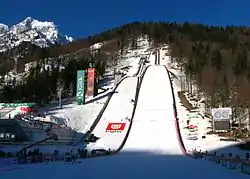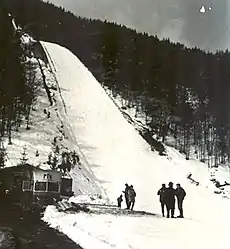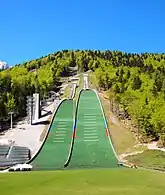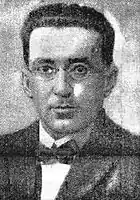Bloudkova velikanka
Bloudkova velikanka ("Bloudek Giant"), also Bloudek-Rožmanova velikanka, is a large ski jumping hill in Planica, Slovenia, originally opened in 1934. In 2001, the hill collapsed and was completely rebuilt in 2012. A new normal hill (HS102) was also built next to Bloudkova velikanka in 2012, replacing the old K90 hill. A total of ten world records were set at the venue in the 1930s and 1940s.
| Bloudkova velikanka | |
|---|---|
 Bloudkova velikanka (right hill) in 2014 | |
| Constructor(s) | Ivan Rožman (orig.) Stanko Bloudek (dev.) Klemen Kobal (new) |
| Location | Planica, Slovenia |
| Operator | ZŠRS Planica |
| Opened | 4 February 1934 (orig.) 14 October 2012 (new) |
| Size | |
| K–point | 125 metres (410 ft) |
| Hill size | 138 metres (453 ft) |
| Hill record | New hill: 147 metres (482 ft) Jarl Magnus Riiber[1] Old hill: 147.5 metres (484 ft) Noriaki Kasai |
| Top events | |
| World Championships | 2023 |
The hill was originally constructed by Ivan Rožman, and was named after Stanko Bloudek. It was later renamed to Bloudek-Rožmanova velikanka in honour of Rožman. A year after opening, Bloudek became the main constructor, improving the hill until his death. In 1936, Josef Bradl became the first man in history to jump over 100 metres (330 ft).
The axis and the name of the hill are protected as a technical monument by the Slovenian Institute for Cultural Heritage, and cannot be changed due to the historical significance.[2]
History
Ski jumping in Planica began to develop when the village of Rateče received railway connections. The first K20 hill was built in 1930, located in the middle of the Planica-Rateče road, with some remains still visible today.[3][4]
On 20 December 1931, the ski resort Dom Ilirija (now Dom Planica) opened at the initiative of Joso Gorec, who was at the time the General Secretary of the Yugoslav Winter Sports Association and a member of the Ilirija Ski Club Ljubljana.[5] Next to the hotel, a swimming pool and tennis courts were built,[5] as Gorec had a vision that Planica would become a modern Nordic ski resort in the future.[6][7]
1932–1934: Construction and opening
In 1932, Joso Gorec asked constructor Stanko Bloudek to construct a large hill, so he drew plans for the K80 hill, which was the largest size allowed by the International Ski Federation at the time.[8] Bloudek found a suitable location and did a geodetic survey, started the construction, but soon ran out of money. Ivan Rožman, the owner of a construction company, immediately stepped in and drew plans for the K90 hill. Gorec decided to rather build a larger hill using Rožman's plans instead of Bloudek's plans, who was then left out.[9]
In 1933, construction began and was completed in only two months, from October to December. Problems arose before construction started as local farmers from the Rateče area did not want to sell the land, but they eventually changed their minds and sold it.
On 4 February 1934,[10] Bloudkova velikanka, constructed by Ivan Rožman, was officially opened with the Kingdom of Yugoslavia National Championships in front of 2,500 people. Franc Palme won the competition with 55 and 60 m (180 and 197 ft) and set the first two hill records and the national record at the same time.[5]
On 25 March 1934, the first international competition was organised where Birger Ruud won the event in front of 4,000 people and also set the first world record in Planica with 92 metres (302 ft).[11] There were also three invalid world record distances with touches or crashes: Birger Ruud at 87 metres (285 ft), Gregor Höll at 89 metres (292 ft), and Sigmund Ruud at 95 metres (312 ft).[12]
1935–1941: Hill expansion, naming arguments and world records
Bloudek returned to Planica and took control over the hill as a constructor/developer until his death in 1959.[5] He constructed a new and larger K106 hill. The same year Rožman stepped out as an engineer in Planica.[5] They argued over who was the original constructor and why the hill was not named after him. Rožman blamed Joso Gorec, who named the hill after his friend Bloudek, although Rožman was the original constructor. For years, there was a public misconception that Bloudek was the original hill constructor. Years later, the hill was renamed to Bloudek-Rožmanova velikanka.
On 17 March 1935 there was an international competition with over 12,000 visitors. During the competition, the world record was set by Stanisław Marusarz (95 metres) and Reidar Andersen (93 and 99 metres).[13][14][15][16]
On 15 March 1936, Josef Bradl became the first man in history to have officially jumped over 100 metres, landing at 101.5 metres (333 ft). The distance had to be displayed as 101 metres on the scoreboard due to lack of space.[9][17][18] Two years later, Josef Bradl won the Ski Flying Study competition with another world record at 107 metres (351 ft) with minor hill improvements.[19][20]
On 2 March 1941, the last Ski Flying Study competition before the World War II outbreak in Yugoslavia was held, with 15,000 spectators in attendance.
After two scheduled rounds and Rudi Gering's world record distance at 108 metres (354 ft), the organizers wished to end the event due to safety concerns, but it continued on Germany's request. The fourth and final round had a series of long jumps: Heinz Palme reached 109 metres (358 ft), but a ground touch invalidated his world record distance. Then Gering set the world record at 118 metres (387 ft), winning the official afternoon competition. Right after him the rest jumped in that order: Hans Lahr (111 metres), Paul Krauß (112 m), and Franz Mair (109 m with fall).[21][22][23]

1947–2001: The last hill world record, World Cup, and collapse
On 24 March 1947, the first post-war competition was held. The winner of the Ski Flying Week was Rudi Finžgar, who also set a new national record of 102 metres (335 ft) during training.[24][25]
Between 14 and 17 March 1948, there was a four-day international ski flying week competition in front of a total 20,000 spectators. Fritz Tschannen won the competition, and also set the last world record on the hill at 120 metres (390 ft). There were also two world record distance crashes by Janez Polda (120 metres) and Charles Blum (121 metres).[26][27]
In 1954, the hill was renovated as a new concrete judge tower was built.[5] In addition, the hill was expanded, received a new profile, and was reopened and back in use for the Planica's Ski Flying week in March 1954.[5]
In 1980, Bloudkova velikanka hosted the first FIS Ski Jumping World Cup event. The hill became a standard and regular host of World Cup events until 1998. Since 1998, all Planica events were held on the ski flying hill (Letalnica bratov Gorišek).

The hill was in use until 16 December 2001, when the upper part of the concrete foundation collapsed during snowmaking.[5][28] In the same year, the last international competition on the old hill was held. For many years after the collapse of the hill, there were plans to rebuild it.[29] A decade later, in July 2011, they demolished the inrun, the judge tower and the television tower,[5] but left the "German tower" which is part of the Slovenian culture heritage.[30] The last construction point of the old hill was at K130 and the last hill size at HS140.
2011–present: Reconstruction
In July 2011, the Slovenian government and the Planica Nordic Centre signed a contract for the complete renovation of the hill, worth €6.2 million.[31] At the same location where the original large hill was standing, which is also part of the Slovenian culture heritage, they rebuilt the hill at the hill size of 139 metres with a new profile, inrun, and judge and television towers.[32] Right next to the large hill they built a new normal hill with the hill size of 104 metres. Both hills were designed by Slovenian architects Matej Blenkuš, Miloš Florijančič and Klemen Kobal.[32] The hills were opened on 14 October 2012 with the national championships.[33]
The first person who jumped on the new HS139 hill was Aleš Hlebanja.[33] He received this honour because his grandmother was the first to sell a private property around the hill, which was needed for the construction of the Planica Nordic Centre.[34] Primož Peterka was honoured with an inaugural jump on the new HS104 hill.[33] In 2014, Bloudkova velikanka hosted the World Cup event for the first time since 1998, because the main ski flying hill was closed at the time due to major renovations.[35]
Events
Men's ski jumping
| Year | Date | Hill size | Event | Winner | Second | Third |
|---|---|---|---|---|---|---|
| 1934 | 4 February | K90 | KYNC | |||
| 25 March | K90 | International | ||||
| 1935 | 17 March | K106 | International | |||
| 1936 | 15 March | K106 | International | |||
| 1938 | 16 March | K106 | Study Flying | |||
| 1940 | 10 March | K120 | Study Flying | |||
| 1941 | 2 March | K120 | Study Flying | |||
| 1947 | 24 March | K120 | Study Flying | |||
| 1948 | 17 March | K120 | ISFW | |||
| 1950 | 15–17 March | K120 | ISFS | |||
| 19 March | K120 | Exhibition | ||||
| 1954 | 13–14 March | K120 | ISFW | |||
| 1957 | 9–10 March | K125 | ISFW | |||
| 1960 | 26–27 March | K120 | ISFW | |||
| 1963 | 22–24 March | K120 | KOP | |||
| 1966 | 25–27 March | K120 | ISFW | |||
| 1968 | 24 March | K120 | 3rd Memorial | |||
| 1973 | 25 March | K120 | 6th Memorial | |||
| 1975 | 12 April | K120 | Kongsberg | |||
| 13 April | K120 | 7th Memorial | ||||
| 1976 | 20 March | K120 | Kongsberg | |||
| 21 March | K120 | 8th Memorial | Cancelled after 14 competitors due to strong wind[36] | |||
| 1978 | 19 March | K120 | 9th Memorial | |||
| 1980 | 22 March | K120 | World Cup | |||
| 1981 | 22 March | K120 | World Cup | |||
| 1982 | 28 March | K120 | World Cup | |||
| 1983 | 27 March | K120 | World Cup | |||
| 1984 | 25 March | K120 | World Cup | |||
| 1986 | 23 March | K120 | World Cup | |||
| 1988 | 27 March | K120 | World Cup | |||
| 1989 | 26 March | K120 | World Cup | |||
| 1990 | 24 March | K120 | World Cup | |||
| 25 March | K120 | World Cup | ||||
| 1992 | 28 March | K120 | World Cup Team event |
|||
| 29 March | K120 | World Cup | ||||
| 1993 | 27 March | K120 | World Cup Team event |
|||
| 28 March | K120 | World Cup | ||||
| 12 December | K120 | World Cup | ||||
| 1995 | 9 December | K120 | World Cup Team event |
|||
| 10 December | K120 | World Cup | ||||
| 1996 | 24 March | K120 | Exhibition | |||
| 1998 | 21 March | K120 | World Cup | |||
| 22 March | K120 | World Cup | ||||
| New hill | ||||||
| 2014 | 21 March | HS139 | World Cup | |||
| 22 March | HS139 | World Cup Team event |
||||
| 23 March | HS139 | World Cup | ||||
| 2023 | 3 March | HS138 | NWSC | |||
| 4 March | HS138 | NWSC Team event |
||||
Women's ski jumping
| Year | Date | Hill size | Event | Winner | Second | Third |
|---|---|---|---|---|---|---|
| 2014 | 22 March | HS139 | World Cup | |||
| 2023 | 1 March | HS138 | NWSC |
List of world records
A total of ten official world records have been set at the hill.[23][37]
| No. | Date | Athlete | Length |
|---|---|---|---|
| 36 | 25 March 1934 | 92 metres (302 ft) | |
| 37 | 14 March 1935 | 93 metres (305 ft) | |
| 38 | 15 March 1935 | 95 metres (312 ft) | |
| 39 | 15 March 1935 | 99 metres (325 ft) | |
| 40 | 15 March 1935 | 99 metres (325 ft) | |
| 42 | 15 March 1936 | 101.5 metres (333 ft) | |
| 43 | 15 March 1938 | 107 metres (351 ft) | |
| 44 | 2 March 1941 | 108 metres (354 ft) | |
| 45 | 2 March 1941 | 118 metres (387 ft) | |
| 46 | 15 March 1948 | 120 metres (390 ft) |
Srednja skakalnica (HS102)
| Srednja skakalnica | |
|---|---|
| Constructor(s) | Klemen Kobal |
| Opened | 14 October 2012 |
| Size | |
| K–point | 95 metres (312 ft) |
| Hill size | 102 metres (335 ft) |
| Top events | |
| World Championships | 2023 |
Srednja skakalnica (literally "Normal hill") is a HS102 normal hill, designed by Klemen Kobal.
It was built in 2012 next to Bloudkova velikanka and replaced the old Srednja Bloudkova K90 hill, which was in use until 2011. It is called simply "Normal hill" because the axis and the name of Bloudkova velikanka are protected by a monument and cannot be changed or used in other structures.[2]
The hill was built as an accompanying facility mainly for the organization of the FIS Nordic World Ski Championships, for which Planica ran several times.
Women's ski jumping
| Year | Date | Hill size | Event | Winner | Second | Third |
|---|---|---|---|---|---|---|
| 2014 | 25 January | HS104 | World Cup | |||
| 26 January | HS104 | World Cup | ||||
| 2023 | 23 February | HS102 | NWSC | |||
| 25 February | HS102 | NWSC Team event |
Men's ski jumping
| Year | Date | Hill size | Event | Winner | Second | Third |
|---|---|---|---|---|---|---|
| 2023 | 25 February | HS102 | NWSC |
References
- "Riiber v Planici četrtič do zlate kolajne, Brecl 37" (in Slovenian). RTV Slovenija. 4 March 2023. Retrieved 4 March 2023.
- Štok, Katja (25 March 2012). "Nordijski center Planica – izjemen kompleks svetovnih dosežkov" (in Slovenian). RTV Slovenija. Retrieved 15 April 2022.
Ime Bloudkova velikanka je spomeniško zaščitena, kot tudi sama os skakalnice.
- Teran Košir, Alenka; Mavrič, Petra (15 March 2018). "Dogodki, ljudje in stvari, ki so zaznamovali Planico" (in Slovenian). Siol. Retrieved 1 December 2020.
- "K25, Rateče". skisprungschanzen.com. Retrieved 1 December 2020.
- "Planica od skromnih začetkov do doline skakalnih rekordov (kronologija)" (in Slovenian). Slovenian Press Agency. 19 March 2019. Retrieved 1 December 2020.
- "Smučarsko slavje pod Jalovcem". Jutro (in Slovenian). 21 December 1931. p. 1. Retrieved 1 December 2020.
- "Praznik našega zimskega sporta". Slovenski narod (in Slovenian). 21 December 1931. p. 1. Retrieved 1 December 2020.
- "Planiška letalnica z vidika geodezije" (PDF). geodetski-vestnik.com (in Slovenian). 2004. Retrieved 2 December 2020.
- Guček, Aleš (13 March 2010). "Neznana znana Planica". smucisca.net (in Slovenian). Retrieved 1 December 2020.
- "Bloudkova velikanka". travel-slovenia.si (in Slovenian). Retrieved 11 March 2016.
- "Svetovni rekordi na naših tleh / Rekord za rekordom". Jutro (in Slovenian). 26 March 1934. p. 1. Retrieved 1 December 2020.
- "Višek smučarske sezone". Slovenec (in Slovenian). 25 March 1934. p. 14. Retrieved 1 December 2020.
- "V Planici so že dosegli 93-metrsko znamko". Jutro (in Slovenian). 15 March 1935. p. 7. Retrieved 1 December 2020.
- "V Planici tik pred zaželjenim ciljem". Jutro (in Slovenian). 16 March 1935. p. 7. Retrieved 1 December 2020.
- "Andersen: 99 m". Slovenec (in Slovenian). 16 March 1935. p. 2. Retrieved 1 December 2020.
- "99 Meter in Planica! Der Norweger fliegt zweimal 99 Meter". Mariborer Zeitung (in German). 17 March 1935. p. 8. Retrieved 10 August 2021.
- "Planica — 101 m!". Jutro (in Slovenian). 16 March 1936. p. 1. Retrieved 1 December 2020.
- "Smuške tekme na Planici brez Norvežanov". Ponedeljski Slovenec (in Slovenian). 16 March 1936. p. 1. Retrieved 1 December 2020.
- "107 m na planiški skakalnici". Slovenec (in Slovenian). 16 March 1938. p. 7. Retrieved 1 December 2020.
- "Bradl je skočil 107 m". Slovenski narod (in Slovenian). 16 March 1938. p. 4. Retrieved 1 December 2020.
- "Veliki dan smuških poletov v Planici". Slovenec (in Slovenian). 2 March 1941. p. 4. Retrieved 1 December 2020.
- "18 skokov nad 100 metrov, od njih dva na 106 m". Jutro (in Slovenian). 1 March 1941. p. 8. Retrieved 1 December 2020.
- "Znamki 101 za nas in 108 m za Nemce". Jutro (in Slovenian). 3 March 1941. p. 1. Retrieved 1 December 2020.
- "V Planici pet poletov nad 100 metrov". Slovenski poročevalec (in Slovenian). 23 March 1947. p. 6. Retrieved 1 December 2020.
- "Teden smuških poletov v Planici je zaključen". Slovenski poročevalec (in Slovenian). 25 March 1947. p. 5. Retrieved 1 December 2020.
- "Izredni uspehi jugoslovanskih in inozemskih skakalcev v Planici". Slovenski poročevalec (in Slovenian). 16 March 1948. p. 6. Retrieved 1 December 2020.
- "Planica naj ostane edina mamutska skakalnica na svetu". Slovenski poročevalec (in Slovenian). 18 March 1948. p. 7. Retrieved 1 December 2020.
- "Bloudek-Rožmanova velikanka v Planici se je podrla" (in Slovenian). Slovenian Press Agency. 17 December 2001. Retrieved 1 December 2020.
- Potočnik, Brigita (28 August 2005). "Počasna obnova Bloudkove velikanke". 24ur.com (in Slovenian). Retrieved 2 December 2020.
- Fon, Boštjan (27 September 2011). "Od Bloudkove velikanke ostal le Nemški stolp". Slovenske novice (in Slovenian). Retrieved 1 December 2020.
- T. V. (8 July 2011). "Čakanja je konec: začela se bo obnova Bloudkove velikanke" (in Slovenian). RTV Slovenija. Retrieved 1 December 2020.
- "Foto in video: Nordijski center Planica – izjemen kompleks svetovnih dosežkov" (in Slovenian). RTV Slovenija. 16 March 2016. Retrieved 1 December 2020.
- S. J. (14 October 2012). "Foto/video: Primož Peterka v Planici odprl prenovljeni ponos slovenskega športa" (in Slovenian). RTV Slovenija. Retrieved 1 December 2020.
- Lopatič, Jaka (14 October 2012). "Hlebanja: Babici sem se že zahvalil" (in Slovenian). Siol. Retrieved 1 December 2020.
- Lopatič, Jaka (18 March 2014). "Planica po svetovni rekord prihodnje leto, letos po svetovno prvenstvo" (in Slovenian). Siol. Retrieved 1 December 2020.
- "Veter je zaprl skakalnico". Delo (in Slovenian). 22 March 1976. p. 9. Retrieved 23 October 2022.
- Da. B. (15 March 2016). "Kdo in kdaj je pod Poncami podrl rekord?". Žurnal24 (in Slovenian). Retrieved 24 January 2018.
